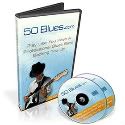In an earlier edition of guitar chord theory we discussed how to stack thirds on any scale to build the chords for that key. Using the same C major scale as in guitar chord theory part 1 we are going to look at how chords are built from a different stand point. The objective of this lesson is to recognize the intervals that make up major and minor chords
What is an interval?
An interval is the distance between two notes. On the guitar one fret is considered a half tone and two frets is a whole tone. The major scale is comprised of seven tones: C D E F G A B that are spaced as a series of whole and half steps. The exact interval sequence is W W H W W W H where W = whole tone and H = half tone.
Notes in C major
l--B--l--C--l------l------l
l------l--G--l------l--A--l
l--D--l------l--E--l--F--l
l--A--l------l--B--l--C--l
l--E--l--F--l------l--G--l
l------l--C--l------l--D--l
Interval sequence starting with root note C
l--W--l--H---l------l------l
l-------l--W--l------l--W--l
l--W--l-------l--W--l--H--l
l--W--l-------l--W--l--H--l
l--W--l--H---l------l--W--l
l-------l--C---l------l--W--l
In modern western music theory the major is considered to be the mother scale as to which all others are related to. There are seven tones in the scale and they are numbered 1 2 3 4 5 6 7 accordingly. This is where it gets tricky. A major chord is said to be made up of the 1st, 3rd, and 5th tones of a major scale. This means that by playing the 1st, 3rd and 5th scale degrees of the major scale we will get a major triad.
Numbered Scale Degrees
l--7--l--1---l------l------l
l------l--5--l------l--6---l
l--2--l------l--3--l--4---l
l--6--l------l--7--l--1---l
l--3--l--4---l-----l--5---l
l------l--1---l-----l--2---l
Major Triad
l-----l--1--l-----l------l
l-----l--5--l-----l------l
l-----l-----l--3--l------l
l-----l-----l-----l--1---l
l-----l-----l-----l--5---l
l-----l--1--l-----l------l
You can see from the diagram that all the notes in the chord correspond to those in the scale.
Minor Chords
in guitar chord theory minor chords are said to have a flatted or minor third scale degree. This means that their interval make up as based around the major scale would be 1, minor 3rd and 5th. Notice below how moving the 3rd down one half step we get a minor chord.
Minor Triad
l-----l--1---l------l-------l
l-----l--5---l------l-------l
l-----l-m3-l------l-------l
l-----l------l------l--1----l
l-----l------l------l--5----l
l-----l--1---l------l-------l
When building chords off of scales by stacking thirds you will not always need to think of them as described here, but it is useful to understand this part of guitar chord theory because many instruction books and other people will refer to them in this intervalic manor.
John Robert has been playing guitar for longer than he can remember. Aside from teaching guitar for the last three years he enjoys writing articles about guitar chord theory and other guitar related topics. If you are serious about mastering basic guitar scales you owe it to yourself to check out Jam-o-rama.info





